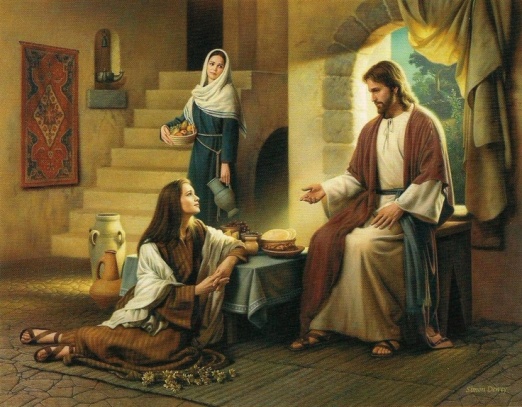The time has come to (finally) finish up the stories of the star points; it only took two years! As a reminder, the star points are:
Martha: The Sister (this one)
If you have absolutely no idea what I’m talking about, you’ll want to check out The Order of the Eastern Star: A Primer.

Mary, Martha, and Jesus
We meet Martha a second time in the Gospel of John. This is definetly one of the more famous stories of the New Testament, and where the story used for Martha’s star point comes from. Mary and Martha’s brother, Lazarus, fell quite ill at one point. The sisters knew that Jesus was near, and they sent a messenger to him, to let him know of the illness. Jesus chose to send back a vague reply, afterwhich, Lazarus died and was buried. Four days later, while they were still grieving, they heard that Jesus would be returning to their city. Martha rushed out to meet him, and said, “Lord, if you had been here, my brother would not have died. But I know that even now God will give you anything you ask.” Jesus then said to her, “Your brother will rise again.” To which Martha replied, “ I know he will rise again in the resurrection on the last day.” Jesus said to her, “I am the resurrection, and the life. He who believes in me will live, even though he dies; and he who lives and believes in me never dies. Do you believe this? (Traditionally, “Believest thou this?)” Martha replied that she did, and Jesus took her to her dead brother’s tomb, and told her to open it. He then called out to Lazarus, who walks out of the tomb, alive again.
We see Martha one last time, later in the book of John, where she serves a meal held in the honor of Jesus and her brother.
Although it is broken up into a few pieces, there is a glaringly obvious lesson taught by Martha; that of faith. Martha kept faith in Jesus, even after he did not appear when they called to him, even after the death of her brother Lazarus. Although Martha is a New Testament heroine, it cannot be denied that the lesson can be brought to all other walks of faith as well. Not so much that you should have faith in Jesus, but more that you should have faith in something, especially something that is more than yourself. While holding steadfast onto faith in an hour of dire need can be quite trying, it often makes of a better outcome. An oft quoted reason for choosing Martha, was that it was known that the majority of OES members would be homemakers like Martha, not dreamers like her sister Mary. Martha was shown multiple times worrying about the state of the household, and serving guests in her home. Personally, I feel that Martha is the most relatable of the star points. Maybe we haven’t all lost our husbands, or been forced to give up our religion, but I would imagine that most all of us have had a time where our faith, in anything, was questioned, and maybe even faltered. Martha serves as the reminder for how important it can be.
Sister Martha
To some hearts overburdened with sorrow;
And to whim the world seems dark and drear,
May your voice be the one to speak comfort,
To the saddened ones bring hope and cheer.
And to teach, Death is the only portal,
That through which breaks Eternity’s dawn,
Thus revealing the glory and splendor,
And the light of an eternal morn.
The bright morn of a day never-ending,
Of a life all-immortal to come,
Which ours will be, through a faith in God’s promise,
Ours at last when our Life’s day is done.



